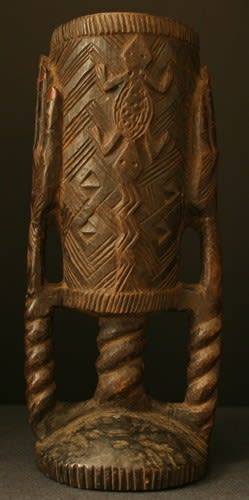Figurative Kuba Cup, 20th Century CE
Wood
SP.143 (LSO)
This striking object is a highly unusual example of a Kuba wine cup. These items are usually cephalomorphic (head-shaped) with abstract designs. In this case the sculptor has radically re-interpreted...
This striking object is a highly unusual example of a Kuba wine cup. These items are usually cephalomorphic (head-shaped) with abstract designs. In this case the sculptor has radically re-interpreted the standard design, and come up with a tubular cup on a thin barley-twist stem, supported on either side by long, angular hands on barley-twist wrists than spring from the small, low conical base. The backs of the hands and the body of the cup are decorated with hatched herringbone designs in double-diamond motifs. Both sides of the cup (i.e. between the hands) are decorated with a snake/lizard motif, the heads of the animals facing upwards towards the rim.
The Kuba are a large tribe comprised of various smaller entities including the Bushoong, Ngeende, Kete, Lele, Binji, Dengese, Mbuun and Wongo peoples. They are quasi-autonomous within the Kuba polity but are related genetically and artistically. Their social systems are hereditary monarchies headed by the “Mushenge” (Nyim), who is responsible for the spiritual and material wealth of his people; each of the subgroups was represented by an elder who sat on a royal council. The kingdom was founded in the early 17th century by a major leader named Shyaam a-Mbul a Ngoong-Shyaam who united disparate groups under his authority. The resulting entity became highly productive and exploited trade networks through the area, becoming very wealthy in the process. This led to an increased artistic oeuvre and ever more elaborate royal regalia and statuary. Their religion was based upon a creator god named MBoom, while more immediate concerns were the province of a being named Woot who was involved with more tangible issues; the Kuba are also known as the Children of Woot. While not impacted upon by slavery, their kingdom fell to the Nsapo people in the 19th century, and was eventually subsumed into the Belgian Empire.
Artistically, the Kuba are highly prolific. Their art is often extremely ornate and decorated with cowrie shells and geometric and meandriform linear motifs. Their large wood sculptures have an apotropaic function. Much Kuba art is decorated with Tukula – bright red ground camwood powder (called twool by the Kuba), which has a symbolic significance for the group. In addition to the beautifully-rendered court art such as the Ndop statues – which represent kings – they have a habit of decorating utilitarian objects to such an extent that they have been described as a people who cannot bear to leave a surface without ornament. They are perhaps best known for their boxes (ngedi mu ntey) and palm wine cups. These items were used as markers of status in the late 19th century, and the quality of their rendering was used as a bargaining chip when attempting to gain royal favour or influence.
This is a striking and interesting piece of African art.
The Kuba are a large tribe comprised of various smaller entities including the Bushoong, Ngeende, Kete, Lele, Binji, Dengese, Mbuun and Wongo peoples. They are quasi-autonomous within the Kuba polity but are related genetically and artistically. Their social systems are hereditary monarchies headed by the “Mushenge” (Nyim), who is responsible for the spiritual and material wealth of his people; each of the subgroups was represented by an elder who sat on a royal council. The kingdom was founded in the early 17th century by a major leader named Shyaam a-Mbul a Ngoong-Shyaam who united disparate groups under his authority. The resulting entity became highly productive and exploited trade networks through the area, becoming very wealthy in the process. This led to an increased artistic oeuvre and ever more elaborate royal regalia and statuary. Their religion was based upon a creator god named MBoom, while more immediate concerns were the province of a being named Woot who was involved with more tangible issues; the Kuba are also known as the Children of Woot. While not impacted upon by slavery, their kingdom fell to the Nsapo people in the 19th century, and was eventually subsumed into the Belgian Empire.
Artistically, the Kuba are highly prolific. Their art is often extremely ornate and decorated with cowrie shells and geometric and meandriform linear motifs. Their large wood sculptures have an apotropaic function. Much Kuba art is decorated with Tukula – bright red ground camwood powder (called twool by the Kuba), which has a symbolic significance for the group. In addition to the beautifully-rendered court art such as the Ndop statues – which represent kings – they have a habit of decorating utilitarian objects to such an extent that they have been described as a people who cannot bear to leave a surface without ornament. They are perhaps best known for their boxes (ngedi mu ntey) and palm wine cups. These items were used as markers of status in the late 19th century, and the quality of their rendering was used as a bargaining chip when attempting to gain royal favour or influence.
This is a striking and interesting piece of African art.
